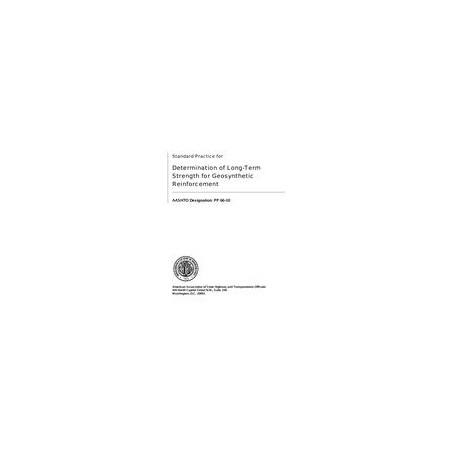Cart 0 Product Products (empty)
No products
To be determined Shipping
$0.00 Total
Product successfully added to your shopping cart
Quantity
Total
There are 0 items in your cart. There is 1 item in your cart.
Total products
Total shipping To be determined
Total
New Reduced price!  View larger
View larger
 View larger
View larger AASHTO PP 66-10
M00001568
New product
AASHTO PP 66-10 Standard Practice for Determination of Long-Term Strength for Geosynthetic Reinforcement
standard by American Association of State and Highway Transportation Officials, 2010
In stock
More info
Full Description
Through this protocol, the long-term strength and stiffness of geosynthetic reinforcements can be determined. This protocol contains test and evaluation procedures to determine reduction factors for installation damage, creep, and chemical/biological durability, as well as the method to combine these factors to determine the long-term strength. The long-term strength and stiffness values determined from this protocol can be used as input values for geosynthetic structure designs conducted in accordance with the AASHTO LRFD Bridge Design Specifications and related FHWA design guidelines. The long-term strength and stiffness values determined from this protocol can also be compared to the required design strength and stiffness values provided in the contract for the geosynthetic structure(s) in question to determine whether the selected product meets the contract requirements. This protocol can be used for initial product qualification or acceptance (e.g., for inclusion in a Qualified Products List), or for quality assurance (QA) to facilitate periodic review of products for which the long-term strength has been previously determined using this standard practice.This protocol has been developed to address polypropylene (PP), polyethylene (PE or HDPE), and polyester (PET) geosynthetics (i.e., geotextiles and geogrids). For other geosynthetic polymers [(e.g., polyamide (PA) or polyvinyl alcohol (PVA)], the installation damage and creep protocols provided herein are directly applicable. While the chemical and biological durability procedures and criteria provided herein may also be applicable to other polymers (for example, hydrolysis testing as described in Annex C is likely applicable to PA and PVA geosynthetics), additional investigation will be required to establish a detailed protocol and acceptance criteria for these other polymers. These other polymers may be considered for evaluation using this protocol once modifications to the chemical/biological durability aspects of this protocol have been developed and are agreed upon by the approval authority.

